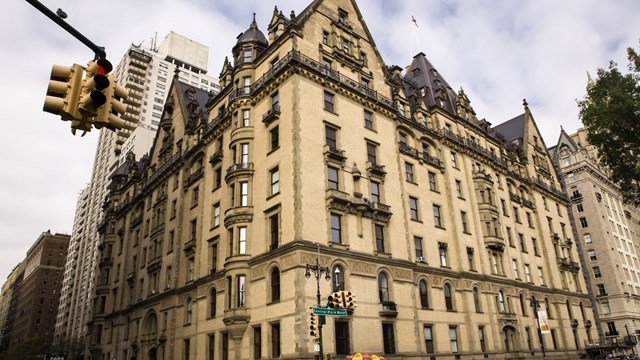When you think landscaping, you probably don’t think of a swanky New York co-op or condo building. After all, landscaping in the usual sense is typically reserved for suburban homes where there is rolling turf, strategically placed trees, sprawling flower beds and maybe even a gazebo or fountain. There's no doubt that greenery and other design elements add to a home’s curb appeal—and in a slowly-improving economy, curb appeal increases value and attracts buyers.
But take a closer look at the outside of that same luxury high-rise and you’ll see that exterior landscaping is actually a part of the building’s look. Whether it’s curbside planters, historic shutters or a colorful awning that complement the building’s veneer or dramatic lighting that draws attention to a unique aspect of the façade, there are ways to landscape the building outside that draw its attention to passersby.
“The benefit is definitely curb appeal,” says Howard K. Freilich, CEO of Blondie’s Treehouse in New York City. “It makes a good first impression and increases the value of the building. If the exterior and the plants look good, people will know that the building is taken care of and will want to live there.”
Planning a Picturesque Exterior
With any spring project, sprucing up the building’s exterior starts with planning. “We meet with the client, look at the existing landscape and see how we can make it work better,” says Freilich. “That determines the selection of the plants, the decorative elements, lighting, irrigation, masonry and more.”
Freilich works with a board or committee to determine the look of the exterior. “Then the committee picks the design they like, based upon our recommendations and their budget. Once it’s approved, we design, install and maintain it. If it’s an existing client, we might refurbish a project by removing some elements, pruning trees back because they have outgrown their space, and so forth.”
Alan Tanksely, a New York City interior designer, suggests that clients try to envision the final effect they're shooting for, and keep that firmly in mind. “With many buildings, you don’t know where the entrance is, so you want to picture it, and create a destination—hit them over the head and create drama,” he says.
Follow the Rules
Planning your picturesque exterior and dramatic entrance might come with some limitations, however, depending on the history and design of your building. For example, changing the exterior of a historic row house, including painting window sashes or frames, installing exterior shutters or awnings and more, requires a permit from the New York City Landmarks Preservation Commission (LPC).
“Physically, the possibilities are limited in terms of how much room you have—and the co-ops also have specific covenants and rules as to what can and can’t be done to them,” says Margie Ruddick, a landscape planner and designer from Long Island City.
There are also rules from the New York City Department of Parks & Recreation that govern what kinds of ornamental landscaping a building can have out front, especially when it comes to planting trees. According to the Parks Department, there are two ways to have a street tree planted in front of a property. The tree can be requested or the association or staff can plant one. To plant a tree, a tree-planting permit and a landscape contractor are required. The permit applications can be found on the Parks & Rec website: www.nycgov parks.org.
Any trees planted on city streets must meet the Parks Department’s tree planting standards, including where they are planted. For example, they may not be planted near bus stops or in front of building entrances, so emergency personnel can get through. In addition, tree pits must be designated sizes in order to allow for the root growth of the tree, certain plants must be grouped together and there are requirements when choosing a particular plant species. There are also soil, plant pest control, maintenance and other requirements.
To request a tree, a property owner must submit a service request that can be found on the Parks Department website, or by calling 311. The planting location is first surveyed by a forester to determine the site’s suitability and potential infrastructure conflicts. The department will only grant tree requests on a first–come, first serve basis and will depend on availability. Some requests may take longer than a year. It’s imperative to request a tree as soon as possible as there is only two planting seasons during the year.
“The more trees you plant, the healthier the city is,” says Freilich.
By planting new trees, the building can become part of Mayor Michael R. Bloomberg’s MillionTreesNYC initiative, a citywide, public-private program with a goal to plant and care for one million new trees across the city's five boroughs over the next decade. The benefits of doing so will increase New York City’s urban forest—made up of street trees, park trees, and trees on public, private and commercial land—by 20 percent and achieve many quality-of-life benefits that come with planting trees.
Know What to Plant
No matter what you plant, “Take careful consideration of the environment and choose plants that are perfectly suited to the city’s restrictions,” says Thomas Balsley, a landscape architect and site planner with his own Manhattan-based firm, Thomas Balsley Associates. The city has created a list of recommended plantings. For example, the Gingko tree, a product of Japan, is considered to be one of the hardiest street trees in the city and is on the species list of approved trees by the Parks Department. The Gingko tree is considered to be a median-sized tree that is tolerant of salt, drought, high wind, pollution and high pH factors. The list includes approximately 25 other species of trees suitable for the city, including the Honey Locust, Tulip, Northern Red Oak, and Sweetgum trees.
What trees you choose really can change the look of the building’s exterior. “For example, the Morgans Hotel planted these stately columnar trees that really changed the whole atmosphere of the street,” says Ruddick. “They are formal and beautiful.”
To maintain current plantings, Freilich says that his company uses native predator insects. “Rather than spraying chemicals, we use organic and natural fertilizers and use good insects that eat the bad ones,” he says. “We also make sure to select the right plants for the right atmosphere and choose the proper pH soil and give it the right nutrients to ensure the plant’s success.”
There’s the Diamond District, the Fashion District and, believe it or not, New York City has its own Flower District, located at 28th Street between 6th and 7th avenues. This strip of land is crammed with greenery to choose from.
Other Features
“Shutters are typically not in the vocabulary for most New York architecture, unless it’s an older building,” says Tanksely. “I wouldn’t use it for a contemporary building, it just doesn’t hold interest.”
Tanksely suggests lighting as an emphatic and affordable way to change and illuminate an exterior. “It’s usually the least expensive and has the biggest impact without having to change the architecture,” he says. “If the building does have planters, lighting it can also be very effective to break up the urbaneness of the city and make for a more appealing building.”
However, he suggests thinking in ‘layers.’ “The building should have some depth, so surrounding the entrance with planters gives you some depth and then a permanent awning provides a transition from public to private,” he says.
Consider using texture too. “A lot of things can be done with natural materials that are elegant and urbane,” he says, for example, creating a natural stone wall. “Think of the simplicity of the Seagram’s building, the materials there, the beautiful stone chosen specifically for art in themselves.”
Most importantly, when planning, Tanksely says to look above the first floor. “When you step back you want to look over the whole building, not just one level.”
Think Outside the (Flower) Box
When planning an attractive exterior, Balsley also suggests thinking out-of-the-box and utilizing existing open space to create a Privately-Owned Public Space, or POPS. “They’ve created small little parks or plazas at building entrances or beside them. Some are garden-like and some are plaza-like and they are public open spaces, but they are privately owned.”
Balsley says that sprucing up a building exterior, especially adding greenery, is about more than just picking a type of tree, shrub or flower. “We take any outdoor space and look at it holistically, which means not just beautifying or making it pretty but talking about the goals that the building might have in mind,” he says. “They may be looking for a sustainable landscape, and we help educate them on ways in which their landscape can participate in the green movement. We don’t just look at it as a physical amenity, but think about the cross-section of people who may be using the space and building and how. Our intent is to add value, not only to their investment, but also to the quality of their lives.”
Lisa Iannucci is a freelance writer and a frequent contributor to The Cooperator.






Leave a Comment